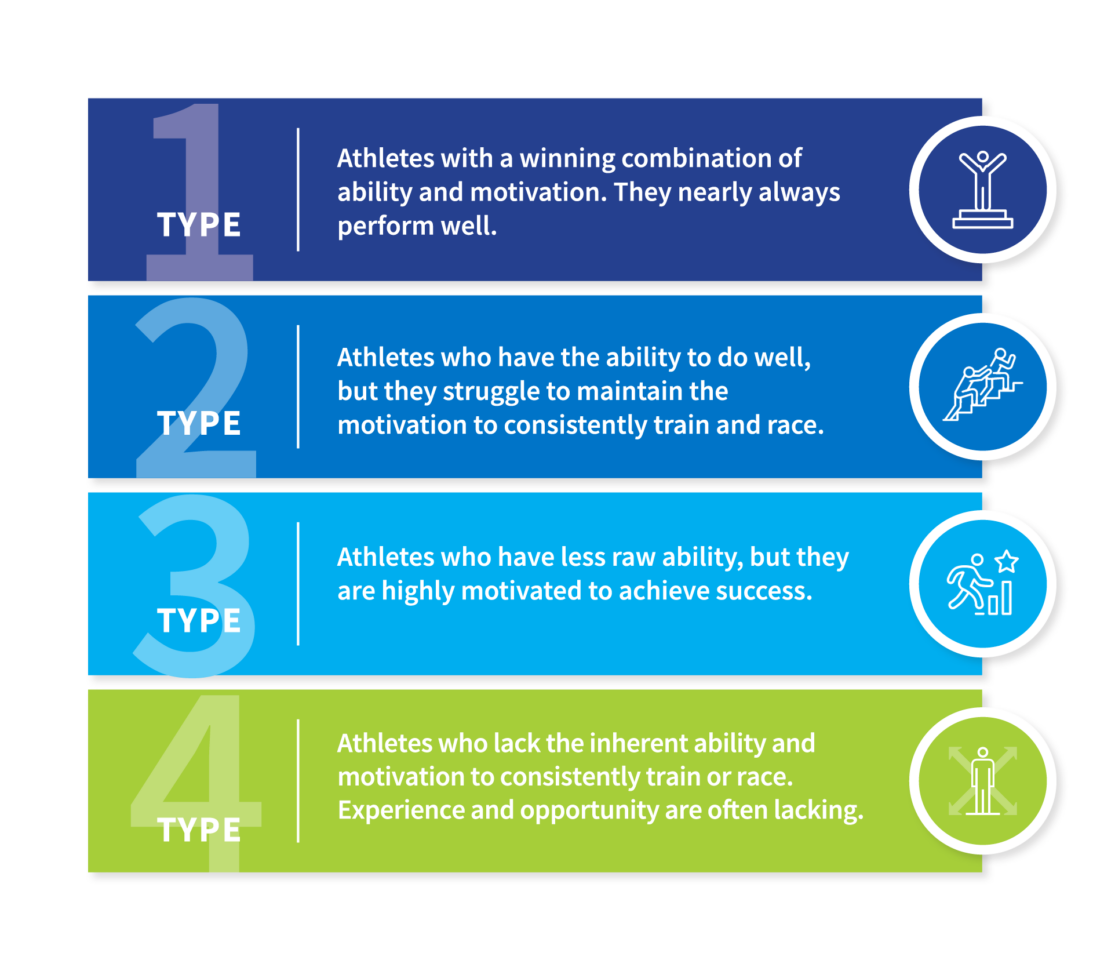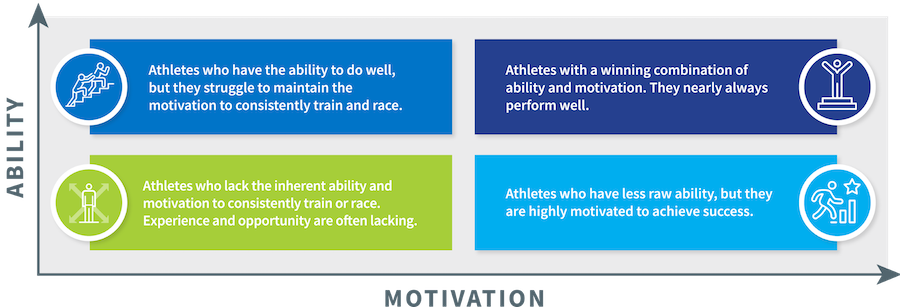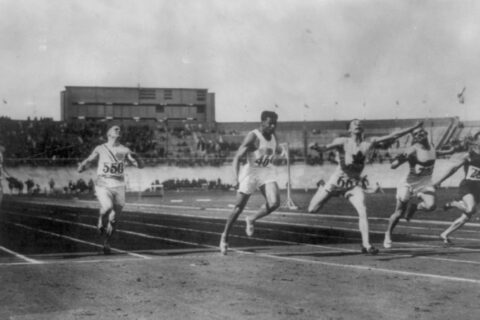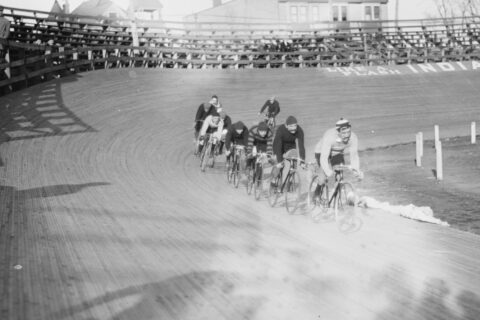In Daniels’ Running Formula, coach Jack Daniels discusses the importance of two ingredients for success in sport: inherent talent or ability and intrinsic motivation. Athletes who are blessed with both qualities are few and far between. Daniels believes that athletes sit in one of four categories, as described below.

Type 1 athletes
Those who have inherent ability and the motivation to use that ability.
These are the champion athletes. They nearly always perform well. Those often described as “elite” athletes are almost certain to fall into this category.
Example: In the late 1990s and early 2000s I coached an athlete who could certainly be described as a Type 1. He was a former collegiate All American who, while I was his coach, went on to qualify for the Olympic Games and win a national championship. There was no doubt he was a Type 1 athlete—he possessed inherent talent and intrinsic motivation. Looking back over my coaching career, there was no other athlete who checked all of the boxes as he did. While there were certainly ups and downs with his career, which is common for all types of athletes, he had a unique way of remaining positive when times were tough and always came to the start line anticipating success. He made coaching fun, easy, and enjoyable as we took on challenging goals together.
Type 2 athletes
Those who have the ability to do well but are not motivated to use their ability.
Daniels refers to these athletes as “coach frustraters.” The coach is aware of how capable these athletes are but is continually reminded that they have little or no desire to fully apply themselves. The coach is likely to become frustrated trying to bring about performances that are indicative of the athlete’s true potential. It could be that the athlete is participating in sport only because of outside influencers such as family, friends, the coach, or another external factor. In other words, the athlete’s motivation is primarily extrinsic. It doesn’t come from deep inside. The coach’s gut reaction to this athlete is often irritation. But being mad at this athlete is unlikely to change their motivation and is more likely to force them out of sport. Instead, Daniels recommends treating them in much the same way the lower-talent, Type 3 athlete is treated while discussing the athlete’s options with them. The athlete needs to understand that the sport may not be right for them. By showing these athletes empathy and unconditional support, the coach may be able to foster intrinsic motivation.
Example: At the same time I was working with the Type 1 athlete, I coached another athlete with exceptional talent. He could take on the most difficult task in his sport and make it look easy. He was perhaps the most inherently talented athlete I ever coached. As a junior he won a world championship title. We started working together some time after that achievement.
As I got to know this athlete better, I found myself amazed that he had been so successful in the sport given his lack of motivation to train. For example, if it looked like it might rain, he was likely to skip his workout. Despite his wavering commitment to training, he remained quite competitive as a pro, winning many races and qualifying for world championship events.
On reflection, I certainly fit Daniels’ description of the frustrated coach. I had never encountered an athlete like this in my career. I had no ideas for dealing with his lack of motivation. I could have used coach Daniels’ guidance. Looking back, I believe this athlete was likely stretching out his career because he had a parent who was well known in the sport. While I’ve coached other athletes with high ability and low motivation, he outperformed all of them when it came to his lack of incentive to train.
Type 3 athletes
Those who are lacking in ability but have great motivation to achieve success.
Daniels calls these athletes “self-frustraters.” They are driven to perform at a very high level but they are lacking the genetics to do so. They are easily coached and will do anything the coach proposes—and more—to succeed. As a result, they are prone to overtraining. They are also often frustrated because they are usually beaten by the Type 2 athlete who lacks motivation to train and works out haphazardly. Once again, the coach plays a key role in helping the athlete to cope with the challenge of seeking a frustratingly high level of performance that seems to never be within reach. While the Type 2 athlete faces a mental barrier that can be overcome if intrinsic motivation is somehow developed, the Type 3 athlete has little guarantee of becoming a high performer regardless of the coach’s level of support. It’s somewhat easier to facilitate a positive change in inherent motivation for an athlete with significant ability than it is to create a comparable change to an athlete’s physiology.
Example: In the waning days of my coaching career I worked with a 50-something age group athlete for two seasons. He was fun to coach as he was always motivated and eager to do whatever I proposed. In fact, he couldn’t do enough. He had a burning desire to perform at a high level in his sport, but I could tell from the start that he was lacking physiological talent. I attended the first race he did under my coaching. He had worked long and hard for it, but it just wasn’t his day. This reality became apparent to me well in advance of race day. Consequently, I had shifted it to be a C-priority event on his schedule. But my client never stopped thinking of it as an A-priority event. Knowing he would be tested in the mountains of Colorado, having trained in the flatlands and low altitude of Texas, I couldn’t be sure he would finish. But he did manage to finish the race—coming in last and well behind the closest finisher. He collapsed on the finish line and looked up at me, asking how he’d placed in his age group. He certainly wanted to succeed. While he was a great pleasure to work with, he was always frustrated in seeking new and unique ways to become faster.
Type 4 athletes
Those who lack ability and are not motivated.
Many coaches are unlikely to encounter this type of athlete, usually because they don’t consider them to be a viable audience. These athletes could very well be a Type 1 participant in some other equally important field of endeavor, such as playing a musical instrument or studying the universe or writing poetry. Ability and motivation likely exist in a different field in significant measure.
Example: In my own coaching career I never worked with a Type 4 athlete. The majority of the athletes I worked with were focused on performance and I gauged their intrinsic motivation in my screening process.
There are coaches who have found great success and fulfillment working with these athletes, a few of whom you’ll encounter later in this module. Coaches like Scott Saifer, Joe LoPresto, and Christine Schirtzinger help Type 4 athletes achieve a wide variety of goals through endurance sport by applying the skills of a good coach, and some patience too. These coaches might convince you that many of these athletes only need to be given an opportunity.

Opportunity doesn’t knock on every door
Aside from talent and motivation, there’s also a third ingredient that Daniels addresses—opportunity. This is one we often overlook. Opportunity may come in the form of genetics, such as tall basketball players, quick soccer players, and small jockeys. And there is also some degree of luck involved. Luck implies that a motivated person is in the right place at the right time. Walking down a busy street you may encounter scores of people who are physiologically blessed with what it takes to break a world record or perform at the highest possible level in a given sport, but they never had the opportunity. They were born at the wrong time, lived in the wrong place, didn’t have the time to invest in sport, couldn’t afford it, or had no one to guide them in the right direction.
Example: My father, George Friel, took up high jumping in grade school. He showed talent and even at a young age he was motivated to keep at it. But at age 12 his father died. As the Great Depression began to take hold of the economy, he had to drop out of school and get a job to pay the family’s bills. So much for high jumping. Could he have been a good high jumper? No one knows, as he never got the opportunity, despite apparently having the motivation and some measure of talent.





